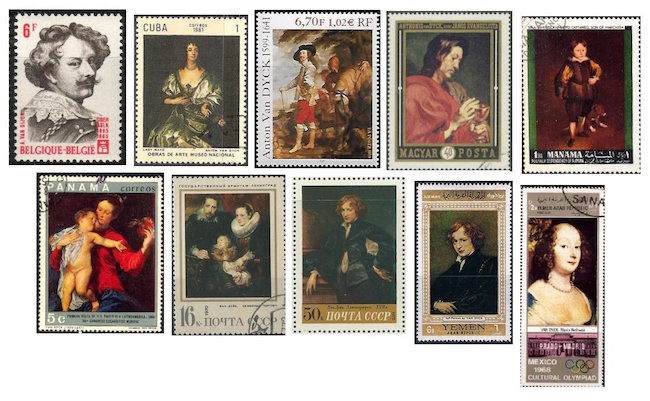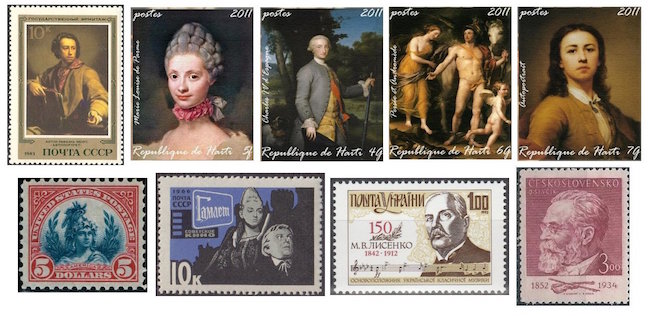The Arts on the Stamps of the World — March 22
An Arts Fuse regular feature: the arts on stamps of the world.

By Doug Briscoe
Well, quite an interesting mixed bag of talents share this March 22 birthday, from Flemish painter Anthony van Dyck to later artists Anton Raphael Mengs and Thomas Gibson Crawford (who is or should be of considerable importance to Bostonians) to Chico Marx and William Shatner and Andrew Lloyd Webber! Along the way we’ll meet Soviet film director Grigori Kozintsev, Ukrainian composer Mykola Lysenko, Czech violinist Otakar Ševčík, and Cuban bandleader Jorge Anckermann.
The paintings of Sir Anthony van Dyck (22 March 1599 – 9 December 1641) are represented on a great many stamps of many nations. I could fill pages with them, but I restrain myself and offer only a marginally excessive group of ten, arranged, quite arbitrarily and lazily, alphabetically by country. So first, as it turns out, we have no painting at all, but rather an etching, a Self-portrait dated around 1630 and seen on a Belgian stamp. Then we have Anne Villiers, Lady Dalkeith (c1640) on a Cuban stamp of 1981, a famous portrait of English King Charles I at the Hunt (c1635) on one from France (1999), an early work, Saint John the Evangelist (c1618-20) from Hungary (1969), and, completing the first row, one issued by the UAE state of Manama, a portrait of little Filippo Cattaneo, Son of Marchesa Elena Grimaldi, dated 1623. The second row begins with a Madonna and Child (I couldn’t find a year for this one) issued by Panama to mark the first visit of Pope Paul VI to Latin America in 1969. From Russia come two stamps, Family Portrait and another Self-Portrait, this time in oils, both from about 1621. Both of these were in the Hermitage Museum, but it seems the self-portrait is now in the Alte Pinakothek in Munich. We wind up with two stamps from Yemen, the first is a variant of the same self-portrait, and the second is of Van Dyck’s English wife, Lady Maria Ruthven.
Another painter, another century, another “Anthony”. Not nearly so well known to us as van Dyck was Anton Raphael Mengs (March 22, 1728 – June 29, 1779), a German-Bohemian artist who found work in Rome, Madrid, and Saxony. It was his father, a Danish painter, who took 13-year-old Anton to Rome, where he lived for most of the rest of his life, even becoming director of the Vatican school of painting (after, of course, his conversion to Catholicism) in 1754. Five years earlier, he had been appointed first painter to Frederick Augustus, the elector of Saxony, which nevertheless left him free to spend much of his time in Rome, and he was twice invited to Madrid by Charles III of Spain. Mengs was a friend of Casanova and the father of twenty children, some of whom received pensions from Charles. The Russian stamp shows one of Mengs’s best known pictures, a Self-portrait done around 1775, which now hangs in the Uffizi but must at the time of issue (1983) have belonged to the Hermitage. In addition to that stamp I show selections from an unauthorized but beautiful Haitian series: portraits of Maria Luisa of Parma and the Prince of Asturias (the future Charles IV of Spain), both dated c1765; a genre piece, Perseus und Andromeda, done some time between 1770 and 1778, and a much earlier and I think very affecting Self-portrait of 1744.

The American sculptor Thomas Gibson Crawford (March 22, 1814 – October 10, 1857) is best known for various pieces commissioned for the United States Capitol, most immediately the Statue of Freedom on the Capitol dome. This object was chosen for the crowning $5 denomination in a 1922-25 series of definitive stamps showing presidents, monuments, and other Americana. Its original title was Freedom Triumphant in War and Peace, and it has sat atop the dome since 1863. But Crawford, who was born in New York City, has a strong Boston connection with several works that can be visited around the city. His Orpheus and Cerberus of 1839, which was for some time kept at the Boston Athenaeum, is now at the MFA. A bust of Josiah Quincy is still housed at the Athenaeum, while Crawford’s Hebe and Ganymede is also at the MFA, to which it was donated by one C. C. Perkins, a gentleman who also presented Crawford’s bronze statue of Beethoven to the Boston Music Hall; it now resides at the New England Conservatory. A statue of James Otis that used to be seen at the chapel at Mount Auburn Cemetery is now in Sanders Theater. Incidentally, Crawford was married to a sister of Julia Ward Howe. He died in London while seeking treatment for his cancer, and his body was returned to New York.
The acclaimed Soviet director Grigori Kozintsev (22 March [O.S. 9 March] 1905 – 11 May 1973) came from a family of distinguished medical practitioners. He started in the theater by helping to design murals, then by creating with several colleagues a puppet theater, studying at the Free Art Workshops in what was then Petrograd, and forming a long-lasting partnership with Leonid Trauberg, with whom Kozintsev wrote a Manifesto of the Eccentric Theater (1921) and founded its concomitant organization, the “Factory of the Eccentric Actor” (FEKS for Fabrika EKSentricheskovo aktyora). The pair went on to produce plays before entering the arena of film (the workshop was renamed the Film School FEKS). Among their earlier features was an adaptation of Gogol’s “The Overcoat” (1926), and their association continued for a further two decades. Thereafter, Kozintsev alone earned particular kudos for his Don Quixote (1957) and his Shakespearean adaptations, Hamlet (1964) and King Lear (1970). Kozintsev’s on-and-off musical collaborator for over forty years, on the Shakespeare films and for numerous other projects going back to the silent era, was Dmitri Shostakovich, who wrote the music for the silent film The New Babylon (1929), Kozintsev and Trauberg’s first sound film, Alone (1931), and at least a half dozen others. By the way, the actor who portrayed the moody Dane was Innokenty Smoktunovsky, whose birthday is on the 28th of this month.

Mykola Lysenko (22 March [O.S. 10 March] 1842 – 6 November [O.S. 24 October] 1912) was an ethnomusicologist who made arrangements of 500 folksongs and composed many original works, including about ten operas, a string quartet, many Chopin-influenced piano pieces, and over a hundred art songs. This stamp was one of the first to be issued by the newly independent Ukraine in 1992.
Otakar Ševčík (SHEV-chick; 22 March 1852 – 18 January 1934), on graduation from the Prague Conservatory, became concertmaster at the Mozarteum concerts in Salzburg, then in Prague and Vienna. He taught violin at Kiev from 1875 to 1892 before returning to his homeland; he was also director of the Violin Department at the Vienna Music Academy from 1909 to 1918. In his later years he taught in the United States (Boston, Chicago, and New York) and Great Britain. Some of his many pupils were Jan Kubelík, Efrem Zimbalist, and Erika Morini.
Jorge Anckermann (22 March 1877 – 3 February 1941) was a Cuban bandleader who played piano in a trio when he was only ten. He lived in Mexico for a number of years as a teacher and theater director. He wrote pieces for zarzuelas and musical comedies, and around the turn of the century created the original guajira, a form of song that celebrates the Cuban countryside and its people (guajiros). (Most Cubans today, however, associate the term guajira with a newer form that developed in the 1930s.) If I’m not mistaken, Anckermann also did the news.

We saw this Marx Brothers stamp on Zeppo’s birthday last month. Now we present it again for Leonard “Chico” Marx (March 22, 1887 – October 11, 1961), the faux Italian member of the group. As can be seen in some of the films, he was an able pianist, and he had also been a bandleader in the 1930s and 40s, performing with a young newcomer by the name of Mel Tormé.
Captain James T. Kirk, William Shatner (born March 22, 1931), is seen on a number of worldwide stamps in his signature role. I’ve mentioned before that a lot of these souvenir sheets are produced not really to be used as postage but as revenue earners for small nations. Such is the case with all of these except the one from Canada, issued as part of a set commemorating the 50th anniversary of the first broadcast of Star Trek. (Perhaps the fact that Shatner and James Doohan were both born in Canada had something to do with the issuance of this set.)
Andrew Lloyd Webber, who since 1997 has been Baron Lloyd-Webber (born 22 March 1948), is not himself honored with a stamp (as is the case with William Shatner, and that’s as it should be), but his godawful musical Cats (1981), which for some reason ran for 21 years in London and 18 on Broadway, was such a smash hit that it was one of the subjects chosen for a sheet of US stamps that looked back to the events of the 1980s. His father, William Lloyd Webber, was a real composer.
I indulge myself a bit by making mention of three performers I particularly admire: happy birthday to the great Swiss actor Bruno Ganz (born 1941), the enormously talented Keegan-Michael Key (born 1971), and the gifted Reese Witherspoon (born 1976).
A graduate of the University of Massachusetts with a B.A. in English, Doug Briscoe worked in Boston classical music radio, at WCRB, WGBH, and WBUR, for about 25 years, beginning in 1977. He has the curious distinction of having succeeded Robert J. Lurtsema twice, first as host of WGBH’s weekday morning classical music program in 1993, then as host of the weekend program when Robert J.’s health failed in 2000. Doug also wrote liner notes for several of the late Gunther Schuller’s GM Recordings releases as well as program notes for the Boston Classical Orchestra. For the past few years he’s been posting a Facebook “blog” of classical music on stamps of the world, which has now been expanded to encompass all the arts for The Arts Fuse.
